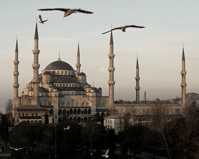By Kate Deimling
ISTANBUL— It’s been over seven weeks now since a night of gallery openings in Istanbul’s Tophane neighborhood erupted into violence. The area features mosques, churches, synagogues, and various small businesses, mostly run by poor Muslim immigrants from the country’s rural eastern region of Anatolia. Since 2008, a number of galleries have moved in bringing with them secular values, risqué imagery, and alcohol-infused opening nights. Until the Tophane Art Walk on September 21, however, the old guard and the newcomers seemed to coexist in wary peacefulness. To better understand what happened that night, ARTINFO took a look at the range of news articles and blog posts examining the violent mob’s motivations, and the ramifications of the incident.
 To recap what happened: gallery-goers loitering on the sidewalk with plastic cups of wine were attacked by a mob of 30 to 50 men wielding knives, batons, broken bottles, pepper spray, and frozen oranges. The attack began in front of Outlet Gallery and then spread to Galeri NON and Elipsis. There were a number of injuries, and approximately a hundred people found shelter inside galleries — one located safely on the third floor and another behind metal security gates. The police arrested a handful of people but later released them, citing the victims’ inability to identify their attackers.
To recap what happened: gallery-goers loitering on the sidewalk with plastic cups of wine were attacked by a mob of 30 to 50 men wielding knives, batons, broken bottles, pepper spray, and frozen oranges. The attack began in front of Outlet Gallery and then spread to Galeri NON and Elipsis. There were a number of injuries, and approximately a hundred people found shelter inside galleries — one located safely on the third floor and another behind metal security gates. The police arrested a handful of people but later released them, citing the victims’ inability to identify their attackers.
Like what you see? Sign up for ARTINFO’s weekly newsletter to get the latest on the market, emerging artists, auctions, galleries, museums, and more.
Initial reports raised the question of whether the unrest could have been caused by a sculpture in the window of Galeri NON depicting founder of the modern Turkish state, Mustafa Kemal Atatürk, as a fallen angel. But an Istanbul blogger who visited the area three weeks after the incident and wrote a lengthy account of his encounters with locals could not find anyone who objected to the depiction of Atatürk (who, moreover, as a staunch secularist, is not especially beloved by the conservative Muslims of Tophane).
Many reports point to alcohol consumption in the galleries as a hot-button issue. Comments posted on a neighborhood Web site in the weeks leading up to the riot objected to drinking at various nearby establishments and urged the community to do something about it. A blogger who witnessed the attack firsthand described ducking down an alley with a friend to escape a mob of more than 20 young men and receiving this warning from a local resident: “There were people out drinking. That’s not accepted in this neighborhood. They’re going to come back. It will happen again. You should leave.” An officer at the local police station told the New York Times that one gallerist’s landlord had warned her to keep her visitors’ alcohol consumption indoors, but that people took their drinks with them anyway when they went outside to smoke. “Going outside with their drinks — that’s how the problem started,” the anonymous officer added.
Many assert, however, that the attack was clearly premeditated, and one blogger on Turkish politics and culture fretted that all the discussions of gentrification and religious intolerance would obscure the necessity of dealing with the organized violence. According to an AP report, this kind of attack “recalled a dark world of impunity and vigilante justice that hindered Turkey’s modern development, and that the nation’s leaders have sought to consign to the past.” Meanwhile, Turkish government officials have downplayed the attack’s significance, with Prime Minister Recep Tayyip Erdogan stating that such incidents occur everywhere.
Typical gentrification issues have indeed been widely reported as having spurred the assailants on. During his tour of Tophane, the aforementioned Istanbul blogger encountered concerns familiar in many neighborhoods across the United States and Europe, from Brooklyn to Berlin: rapidly rising rents, produce that costs ten times as much as before, feelings of being looked down on by newcomers.
It would no doubt be easier to evaluate the political, religious, or socioeconomic overtones of the incident if it could be determined just who perpetrated the violence. German magazine Der Spiegel reported that some local residents attributed the attacks to members of a neighborhood Islamic Group called the Brotherhood. While some have implied that the political group Alperen Ocaklari — which is affiliated with the Grand Unity Party — was involved in the assault, its head, Abdullah Gürgür, denies these accusations, according to Turkish newspaper Today’s Zaman.
via What Happened in the Istanbul Gallery Attack?: A Roundup of Perspectives – ARTINFO.com.

Leave a Reply